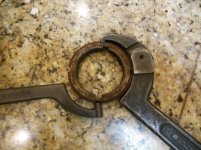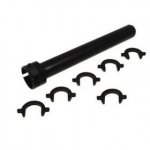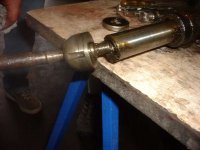Wade Keene
Plastic
- Joined
- Nov 4, 2007
- Location
- Homewood, IL
Hi Everyone,
Hopefully someone can help. I need to make a tool to take apart the steering tie rods on an old MG. The piece I need to get a hold of to unscrew is 1-5/8" in diameter with three slots spaced 120deg apart. The slots are pretty shallow, 1/16" or so and 1/4" wide. The factory tool would look something like a lock nut socket you could find now but I haven't run across anything close or that could be modified.
I was thinking of turning the outer ring of the wrench to the 1-5/8" ID and cutting keyways to weld in lengths of hardened steel stock so they protrude the required distance and have enough meat in the keyway to be secure and transmit enough torque to do the job. These things are notoriously tough to loosen from the base of the tie rod. The base has two holes in the bottom and I was going to make something with two pins in a block of steel to hold in a bench vise to hold it - this would be the easy part. I'm certainly no machinist by trade, I restore old British cars so I've picked up a few things along the way. I have a lathe, drill press, arbor press, some other tools.
I looked around and think I can handle what looks to be basic broaching but the big problem seems to be getting the right setup. Finding 1/4" keyway broach, no problem. Finding 1-5/8" diameter bushing - easy. A 1-5/8" bushing that takes a 1/4" broach - no such thing?
Ideas, anyone? Or am I stuck using a hacksaw and files?
Thanks
Hopefully someone can help. I need to make a tool to take apart the steering tie rods on an old MG. The piece I need to get a hold of to unscrew is 1-5/8" in diameter with three slots spaced 120deg apart. The slots are pretty shallow, 1/16" or so and 1/4" wide. The factory tool would look something like a lock nut socket you could find now but I haven't run across anything close or that could be modified.
I was thinking of turning the outer ring of the wrench to the 1-5/8" ID and cutting keyways to weld in lengths of hardened steel stock so they protrude the required distance and have enough meat in the keyway to be secure and transmit enough torque to do the job. These things are notoriously tough to loosen from the base of the tie rod. The base has two holes in the bottom and I was going to make something with two pins in a block of steel to hold in a bench vise to hold it - this would be the easy part. I'm certainly no machinist by trade, I restore old British cars so I've picked up a few things along the way. I have a lathe, drill press, arbor press, some other tools.
I looked around and think I can handle what looks to be basic broaching but the big problem seems to be getting the right setup. Finding 1/4" keyway broach, no problem. Finding 1-5/8" diameter bushing - easy. A 1-5/8" bushing that takes a 1/4" broach - no such thing?
Ideas, anyone? Or am I stuck using a hacksaw and files?
Thanks











